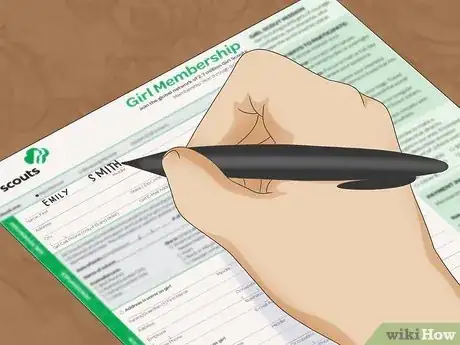This article was co-authored by wikiHow Staff. Our trained team of editors and researchers validate articles for accuracy and comprehensiveness. wikiHow's Content Management Team carefully monitors the work from our editorial staff to ensure that each article is backed by trusted research and meets our high quality standards.
There are 9 references cited in this article, which can be found at the bottom of the page.
wikiHow marks an article as reader-approved once it receives enough positive feedback. In this case, several readers have written to tell us that this article was helpful to them, earning it our reader-approved status.
This article has been viewed 68,552 times.
Learn more...
Daises are a young category of Girl Scouts (Kindergarten and 1st Grade). Daisies are committed to exploring nature, selling cookies, making friends, and earning petals, which are the equivalent of badges for a Daisy Troop.[1] If you are interested in starting a Daisy Girl Scout Troop, the process can be incredibly rewarding. You will need to register with Girls Scouts of USA (GSUSA), pass a background check, and spend some time undergoing basic training in order to operate a troop. From there, you can recruit members and establish your organization. As you move forward, plan a variety of fun meetings for your members and make sure to network with other troop leaders in your area.
Steps
Getting Training
-
1Register as a member of the Girl Scouts of the USA (GSUSA). You cannot get a background check or have your training linked to your name until you are registered as an adult member of the GSUSA. If you were a Girl Scout when the new system was put into place, you might already have an account and can register as an adult member through the MyGS account. Most will not have an account and can easily register online. You can simply go to the main Girl Scout website: go to For Adults and click the "Volunteer Now" button on that page. (See referenced foot note for link to that specific page[2] ). From here, you will enter basic information and may have to answer a few questions about why you are joining Girl Scouts.
- If you have a Troop number assigned to you, make sure you know it before you register so your name can automatically be linked to that troop.
- If you do not know your Troop number or do not see the Troop Leader opening when registering, you will need to call your local council and have them set it up manually after you register. Find your local council here: (See reference foot note for link)[3]
- You will have to pay a $25 registration fee.
-
2Undergo a Criminal Background Check (CBC). All Daisy Troop leaders must pass a CBC. If you register as a Leader Volunteer you will automatically get sent an email requesting you start this process. If you are not assigned a Troop number yet, you will need to contact your local Girl Scout Council to start this process.
- The CBC ensures that you are fit to supervise young children. Each Girl Scout Council will have a slightly different process so contact them if you have any questions.
- Most will ask you to pay for the CBC but will also usually give you an option NOT to pay. If you choose not to pay, the local Girl Scout Council will foot the bill.
Advertisement -
3Select a co-leader, if necessary. You must have two GSUSA registered adults for any size of troop. Larger troops require more GSUSA registered adults depending on their grade level. It is not mandatory to have a designated co-leader. If you are the only leader and there are several parents that will be GSUSA registered, they are able to come and be the second adult without being a leader. However, if you are ever sick, the meetings would be cancelled without a designated co-leader. For this reason, it is highly recommended that you get a second adult.
- You should always have a parent meeting, with the parents of the girls of your troop. This way, you can ask if a parent is interested in taking the steps to become a co-leader, if you do not have one at the start. Make sure you it is someone you feel you can work well with on a semi-professional basis.
-
4Complete online training. All adult registered members of GSUSA, that are involved with the girls, should complete an online training program. It is called Girl Scout Training 101 and takes around 45 minutes. This program goes over the basics of Girl Scouts. (See reference for direct link to Volunteer training page of GSUSA[4] )
- Each local Girl Scout Council will have additional Troop Leader training. Their website will often have links to what can be done online. If you ever have a question about training, reach out to your local Girl Scout Council and they will be more than happy to help.
- Pay close attention during the online training session. You may want to take notes throughout the training session, as some information will be invaluable later on when managing your own troop. If you can, take any training in person, as it often focuses helpful information, while not wasting a lot of time on the less necessary, topics. You also get to ask questions from people that have been through the training sessions before. That is priceless.
- Leader specific training introduces you to the basics of managing a Girl Scout Troop. It talks about the values of Girl Scouts as an organization and explains how to start a bank account. It also shows where you can find information on planning troop activities, how to order materials for your troop. and what materials you will need to run your troop. There may also be information about the logistics for cookie sales.
Establishing Your Troop
-
1Decide ahead of time how large your troop will be. You also do not want to recruit more girls than you are willing or able to lead.
- Besides the number you think you can handle, GSUSA has a Safety-wise[5] requirement for 2 unrelated adult (at least 1 female) GSUSA members with a valid Criminal Background Check (CBC) for every 12 girls. You must have an additional adult GSUSA member with a valid CBC for each additional 6 girls. If you have 13 girls, you will need three adult members at every meeting.
-
2Choose a location to meet. It is important to know if you want to meet at your home, if this is viable, or somewhere such as a school gymnasium or church.
- If it is at your home, you must have all adults in the home registered as adult members of GSUSA with a Criminal Background Check (CBC), regardless of how they are helping at the meeting per Girl Scout policies. While girls can be in public areas with non CBC verified adults, Girl Scouts takes the safety of girls very seriously. No adult that has not been CBC verified can be in any private residence where Girl Scouts meet or attend private meetings.
- If you want a large troop, meeting at your home is not an option. Troops can meet a churches, schools, or community centers. Start calling the local possible meeting areas to ask if it is allowed and if there is a cost to meet there. That might affect how often you meet (for example weekly, twice a month, or daily).
- Talk to your Girl Scout Council before finalizing any meeting location plans or paying any fees. They need to give you permission to meet there.
-
3Choose when you will hold your meetings? While some might choose to decide this during a parent meeting, it is easier to recruit when you can tell parents a clear meeting time and place.
- Meetings can be 60-90 minutes. Most of the official Girl Scout Meeting plans in the book are for 90 minutes, but Kindergarten Daisies often only meet for 60 minutes, as their attention span is shorter.
- As you are working with school-aged children, select a meeting time that is convenient for children and parents. Make sure meeting times occur after school. Keep in mind many parents work a 9 to 5 job. If you meet in the school right at the end of the school day, a meeting that runs until a little after 5 can be convenient, as parents can pick up their kids after work. If an evening works better, after 6:00 p.m., this allows families to grab a bite to eat before you start your Troop Meeting.[6]
- A school is probably the easiest place to host meetings, as girls can go directly from school to their girl scout meeting. If meeting in the evening, it is still a location girls are familiar with and is easy to get to for most parents. Most schools will be willing to accommodate wholesome, after school activities like Girl Scouts without a fee.
-
4Establish a troop bank account. All girl scout troops are required to have a bank account. This is where you will store the funds raised through Troop Dues, Cookie Sales, and other troop fundraising activities.
- Your local Girl Scout Council will have their own regulations regarding establishing a bank account. Contact them for details. The forms will vary by location, but you will usually put down your troop number, your name, the address of your meetings, and other basic contact information. If you have any questions, you can ask other Girl Scouts troop leaders in your area. Rules regarding establishing a bank account in your area are covered during your training.
- Decide on how much your Troop Dues will be as well. Troop Dues are a fee paid by the parents in addition to the $25 membership fee that goes to the GSUSA. Troop Dues go directly to the Troop and are used to get materials for the activities. Some troops will factor in how much it costs to buy the badges the girls will earn during the year and include those in the Troop Dues as well. Others will request parents to purchase the badges. You can decide a hard number in the Parent Meeting, but having a good idea of the cost you expect during the year is helpful.[7]
-
5Recruit troops. After completing training, you should have all the knowledge you need to start your troop. You will want to begin by recruiting members from your community. Remember, Daisies are kindergartners and first grade students.
- The first place you should look is with your local Service Unit. Your local Girl Scout Council can tell you what Service Unit is over the area you live in. They may have recruitment drives you can go to and gain new members.
- Where does your daughter (and co-leader's daughter) already meet with other girls? School, Church, Playgroups, etc. Talk to your daughter's teacher (school or a church's children class) and ask if you can come talk to the class about Girl Scouts. You can give girls who are interested flyers to take home and talk to their parents about after school. Check with your school's PTA to see if there is a Back to School night or a Kinder Play Date you could set up a table to let parents who attend know about Girl Scouts.
- You can create flyers to hang up around schools, daycare and community centers. These can be advertised to both children and parents. You may be able to get flyers directly from your local Service Unit or Girls Scout Council.
- When recruiting members, focus on the positive aspects of Girl Scouts. Talk about the commitment to confidence, togetherness, service, and responsibility. Talk to parents about how joining Girl Scouts can boost a young girl's self-esteem, help her make lifelong friends, and help her develop basic skills like responsibility.[8]
- Let parents know who is eligible to be a girl scout. Parents of transgender children may wonder if their daughters are allowed in Girl Scouts. Reassure these parents that Girl Scouts is open to transgender girls, who are recognized as female by their families and communities. You should also make it clear that Girl Scouts is open to families of any religious background.[9]
-
6Have your first parent/guardian meeting. Before you can have an official Girl Scouts meeting, you will need to have what is called a parent/guardian meeting. This is an event where you meet with parents and guardians of potential troop members. This allows you to answer any questions parents or guardians may have regarding a Daisy Troop. It also allows you to ask for any adult volunteers for things your troop needs right away.
- When arranging the Parent Meeting, make sure you tell them if you need them to leave their kids at home. This is recommended, as you can focus more on details relevant to the parents. If you allow kids to come, make sure there is an activity for them to do while the adults talk. Having a co-leader before this meeting helps, if this is your choice, as one leader can run the kids activity while the other runs the adult meeting.
- To start, you will need to inform parents and guardians about the Girl Scouts and their values. Make sure you mention what your troop is focusing on this year. You could be just doing the Daisy Petals, going on a Daisy Journey and letting the girls earn their petals on their own at home, or focusing on more fun activities that do not have an official badge attached. (See reference for link to the Start Up Guide[10] )
- There are a variety of forms the parents have to fill out before the first Troop Meeting. You can provide these and explain them at this meeting. Some, like the Health History Form, they may not be able to fill out at this meeting. See the next step for more information on the forms.
- Spend a lot of time planning your first parent/guardian meeting. You want to make sure parents and guardians leave the meeting excited about their girls joining a Daisy Troop. Supportive, active parents and guardians are vital to a successful Daisy Troop.[11]
-
7Get all your forms back. Each local Girl Scout Council will have specific rules. The parent/guardian meeting is the place to hand out these forms and answer any questions regarding them. Most local Girl Scout Councils will have these two forms:
- A Permission Form, which dictates how the girls will go home, who is authorized to pick them up, and emergency contact numbers. There is only one form needed for all Troop Meetings, but most councils will need additional forms for any day long outing, overnight activity, or anything that requires the troop to travel a significant distance.
- A Health History or Health Examination form allows you to know what allergies a troop member may have and what medications you are allowed to give them from your troop First Aid kit. It also contains medical information that you can hand to an Emergency Medical Technician (EMT), should you ever have to call 911 for a medical emergency, or take a girl to the ER.[12]
-
8Host your first troop meeting. Once you have hosted your first parents meeting and gotten all the paperwork out of the way, you can host your first troop meeting at your chosen location. The first meetings should be more about the girls getting to know each other and what it means to be a Girl Scout. Earning a badge during the first meeting is up to the leaders to decide.
- Start the first meeting with any opening or closing routines you plan to keep during the year. Many will recite the Girl Scout Promise, Girl Scout Law, and Pledge of Allegiance at the beginning of the meeting and end with a Girl Scout Song and a Friendship Circle. These should be mentioned in you Leadership Training or your Journey guidebooks. Kindergarteners often have trouble with the Girl Scout Law, because they are just learning how to read and it is rather long. First Graders might stumble at the beginning of the year, but many will memorize it before the school year is up. Figure out what works best for your specific age group.
- You can browse the Girl Scout website for ideas on opening day craft activities. Choose a craft that promotes communication and can be used for ice breaking. For example, the girls can each draw pictures of their favorite things. They can then exchange pictures with other members and compare and see contrast in each other's tastes.
- You can start the meeting by getting your troops in a circle. You can have them introduce themselves. You can consider playing a game to help with introductions. Some Daisy Troop leaders play a game like "Duck, duck, goose!" but instead call it, "Daisy, daisy, petal!"
- You should also strive to introduce the basics of a Daisy meeting. There will be a variety of handouts you should have received during your own training that overview a year as Girl Scout Daisy. Daisy Petals have Flower Friends the girls will get to know and go on a 'road trip' with. Daisy Journeys are guided by fictional characters, named Chandra, Cora, and Campbell, who appear in literature and pamphlets throughout the year. You can spend your first day learning a bit about these characters.
Moving Forward
-
1Choose a variety of activities for meetings. The Daisy Troops follow a specific journey through a metaphorical garden in the course of the year.
- Daisy Petals explore the different aspects of the Girl Scout Law and take 11 meetings, if you do one meeting for the Promise Center and one petal for each meeting.
- If you choose to do a Journey (which take nine to 12 meetings), meetings all build up to a service project, called the "Take Action Project." This project can take a variety of directions, depending on your area and the interests of your troop. Try to incorporate a variety of activities into each meeting, that build towards this larger project.
- The idea of the "Take Action" project is to try and make an impact on the community. You can have the girls, for example, help plant a community garden. You can work up to the larger project by having small planting projects each week. One week, for example, your girls can plant a small seed in a tiny pot. They can take it home, water it, and observe its growth. This will teach them basic gardening techniques they can use later on, when working in a community garden.
- The Girl Scouts of the USA has a handbook which includes a sample trajectory of a year of a Daisy Troop. You can refer to this handbook as you plan your meetings, but feel free to deviate from the rules, to suit your own troop's needs.
-
2Plan trips. You can take your troop on a variety of trips throughout the year. They can go to an organic farm, for example, to learn about environmental sustainability.
- Regulations for planning trips vary between Girl Scout Councils. Most will require specific Training that can be anything from a 20 minute online class to a 4 hour in-class training session.
- Plan as many or as few trips throughout the year as you desire. All trips should relate to your "Take Action" project or theme of the year.[13]
-
3Consider a camping trip. The Girl Scouts have no set age limit for camping trips, but your local Girl Scout Council may have specific regulations on Daisy's camping. Talk to you local Girl Scout Council if you want to do an overnight trip, as it might take a while to get the right training and requirements met.
- Any Girl Scout can attend a Girl Scout official Resident Camp even if you, as the leader, do not have the right Camping Training. The Resident Camps usually only require the minimum 2 GSUSA adult members for night time supervision and to chaperone the kids from station to station during the day.[14]
- You can incorporate a variety of activities into a Troop Led camping trip, depending on where you are staying. If you have a friend who owns a farm, for example, you can camp there and teach the girls about horseback riding, animal care, and farming in general. If you are camping near water, you can take the girls canoeing or teach them about swimming. If you are planning water activities, make sure to hire a professional lifeguard and follow all the Safety Activity Checklist.
- It is not uncommon for girls, especially girls who are in the Daisy age range, to feel nervous about camping for the first time. You can help your girls feel less nervous by going over the schedule extensively ahead of time. You can also visit the campgrounds before the overnight stay, so the girl's do not go in without any knowledge of where they are staying. Just remember that if you have a Mother-Daughter Campout, all Mothers must be registered GSUSA members with a valid Criminal Background Check (CBC) in order to attend.
-
4Network with other troop leaders. Remember, Girl Scouts is a community. Take advantage of the community in your area. Network with other troop leaders, usually through your Service Unit meetings. You can do collaborative projects with other Daisy Troops. You can also network with older Girl Scouts.
- Teaming up with a Brownie Troop when your Daisies are ready to bridge to Brownies themselves can make it feel extra special.
- Allowing your girls to see the projects and activities older Girl Scouts are engaging in may provide them with incentive to stay in Girl Scouts.
Community Q&A
-
QuestionHow can I start my own Daisy Girl Scout Troop?
 Community AnswerYou would have to apply for one with the Girls Scouts of America, then follow all the required steps for starting a troop.
Community AnswerYou would have to apply for one with the Girls Scouts of America, then follow all the required steps for starting a troop. -
QuestionHow can I join immediately?
 Community AnswerSign up ahead of time so you have a automatic spot and if you plan on joining now, you may have to wait but most troops will take you in early or late.
Community AnswerSign up ahead of time so you have a automatic spot and if you plan on joining now, you may have to wait but most troops will take you in early or late. -
QuestionCan I start a troop in January?
 Community AnswerYes, you can start a troop in any month of the year.
Community AnswerYes, you can start a troop in any month of the year.
References
- ↑ http://www.girlscouts.org/en/our-program/grade-levels/what-daisies-do.html
- ↑ http://www.girlscouts.org/en/adults/volunteer.html
- ↑ http://www.girlscouts.org/en/about-girl-scouts/join/council-finder.html
- ↑ http://www.girlscouts.org/en/adults/volunteer/volunteer-resources.html?utm_campaign=Redirect&utm_medium=Web&utm_source=training.girlscouts.org
- ↑ www.girlscouts.org/content/dam/girlscouts-gsusa/forms-and-documents/for-adults/volunteer/2012_computer_online_safety_activity_checkpoints.pdf
- ↑ https://www.gswcf.org/content/dam/wcf-images/pdf-forms/Troop-Leader-Start-Up-Guide.pdf
- ↑ https://www.gswcf.org/content/dam/wcf-images/pdf-forms/Troop-Leader-Start-Up-Guide.pdf
- ↑ http://www.girlscouts.org/en/about-girl-scouts/who-we-are.html
- ↑ http://www.girlscouts.org/en/faq/faq/social-issues.html
- ↑ https://www.gswcf.org/content/dam/wcf-images/pdf-forms/Troop-Leader-Start-Up-Guide.pdf
- ↑ https://www.gswcf.org/content/dam/wcf-images/pdf-forms/Troop-Leader-Start-Up-Guide.pdf
- ↑ https://www.gswcf.org/content/dam/wcf-images/pdf-forms/Troop-Leader-Start-Up-Guide.pdf
- ↑ https://www.gswcf.org/content/dam/wcf-images/pdf-forms/Troop-Leader-Start-Up-Guide.pdf
- ↑ http://www.girlscouts.org/en/faq/faq/camping.html

































































